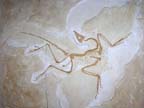 |
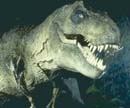 |
 |
 |
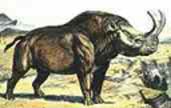 |
Produced
by the Population Genetics and Evolution class, Furman University |
||||
 |
 |
 |
 |
 |
Produced
by the Population Genetics and Evolution class, Furman University |
||||
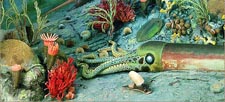 |
The
Ordovician: Arandapis |
 |
||
| Arandapis prionotolepis is
an extinct species of jawless fish that is the oldest known vertebrate
(Wikipedia 2010). This vertebrate lived during the Ordovician period around
480-470 million years ago (Wikipedia 2010). The first remains of Arandapis
were found in Alice Springs, Australia in 1959 and was named after a local
tribe Aboriginal called the Aranda (Wikipedia 2010). These fossils were
the first Ordovician remains found in the Southern Hemisphere (Australian
Heritage Places Inventory 2010). Arandapis in its entirety was about 15 cm long (Wikipedia 2010). It is characterized as having a streamline shaped body covered by drop shaped scales and pad-shaped, diphycercal tail (Janvier 1997). The head and the front of the body are covered by a “flat dorsal shield and a bulging ventral shield” with the eyes and nostrils located at a notch in the anterior end of the dorsal shield (Janvier 1997). There were also two small openings at the top of the dorsal shield which are hypothesized to be light sensory organs (Australian Heritage Places Inventory 2010). It is speculated that Arandapis also had up to fifteen gill openings that were between the dorsal and ventral shield (Janvier 1997). Arandapis, as stated previously had no jaws however; it did have a ventral lip covered in small oral plates (Janvier 1997). The low position of its mouth infers that this fish was a bottom feeder (Wikipedia 2010). These fish were eventually replaced by fishes with jaws and by agnathans, which gave rise to the hagfish and lampreys of today (Australian Heritage Places Inventory 2010). Page by Chapin Hardy |
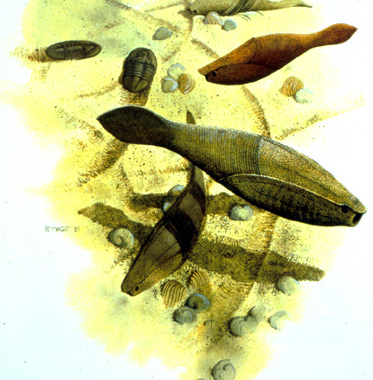 |
| Picture from: www.bertsgeschiedenissite.nl | |
|
University of California Museum of Paleontology. 2010. Understanding Evolution: Opabinia. Accessed February 2010. Smithsonian Institution. 2010. Burgess Shale: Opabinia regalis. Accessed February 2010. Whittington HB. 1975. The Enigmatic animal Opabinia regalis, Middle Cambrian, Burgess Shale, British Columbia. Phil. Trans. R. Soc. Lond. B 271: 1-43. |